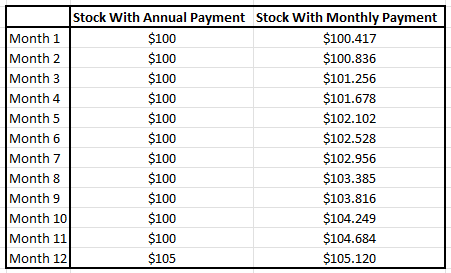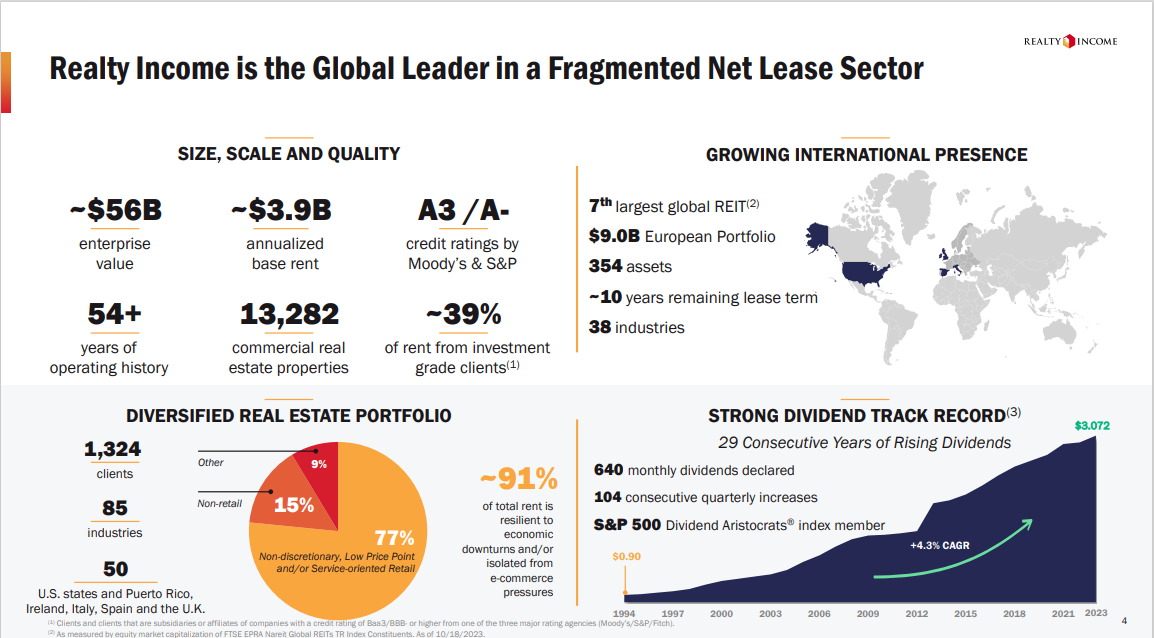Originally published on January 5th, 2023 by Jonathan Weber
Updated on December 27th, 2023
Many investors seek to generate income from their equity holdings. Some investors need regular monthly payments.
There are companies that offer monthly dividend payments. That’s not overly common, but some REITs, mortgage REITs, business development companies, and similar yield vehicles opt for twelve payouts per year, which is the most evenly distributed income stream investors can opt for, as there are no stocks that offer more than 12 dividend payments per year.
There are 54 monthly dividend stocks. You can see our complete list of monthly dividend stocks, with important financial metrics like dividend yields, price-to-earnings ratios, and payout ratios, by clicking on the link below:
In a perfect world, investors would get their income distributed in a very even way, e.g. by getting paid once per day.
But in the real world, that doesn’t work, which is why there are no daily dividend stocks. We’ll explore why and will showcase some examples of stocks that come closest to that, by paying monthly dividends.
What Kind Of Dividend Payments Exist?
Some companies do not make dividend payments at all, or at least not regularly. Among those companies that offer regular dividend payments, quarterly payments are the most common. Many US-based companies offer one dividend payment every three months.
There are also some that offer annual dividend payments or semi-annual dividend payments. Those are more common with international stocks, as many European companies make annual or semi-annual dividend payments. Sometimes, when a company makes semi-annual payments, these payments are uneven, e.g. with the spring dividend being larger than the fall dividend during most years.
Dividends: The More Regular, The Better?
When a stock makes a certain dividend payment per year, can we say that it is better when that total annual dividend is distributed in many smaller payments that are evenly distributed over the year? There are some arguments that suggest that this is indeed better.
First, for retirees and other income investors that live off the dividends they receive, it is easier to match their cash flows with their cash needs when dividend payments are made very regularly, e.g. monthly.
When dividends are, on the other hand, only made yearly, that requires a lot more planning, as investors have to match the once-per-year income proceeds with their regular weekly or monthly expenses.
With monthly dividend payments, that’s easier, and with (hypothetical) daily dividends, that would be even easier.
For income investors that do not yet live off their dividends, dividend reinvesting is important. Over time, reinvestment of dividends plays a huge role in an investor’s total returns, as the total stock holdings grow over time.
Since this results in higher dividend proceeds down the road, which leads to more shares being purchased, all else equal, the compounding effect can make a huge difference over time.
When a stock offers more regular dividend payments, e.g. monthly versus once-per-year, then there are more opportunities for dividend reinvestment and an investment compounds at a slightly faster pace.
If a company were to pay a $5 per share dividend per year and if that company’s share price is $100, that results in a $105 investment after one year if there is a single dividend payment at the end of the year and if the share price does not move upwards or downwards. The following table shows the compounding effect of monthly dividend reinvestment over time:
Source: Author’s Calculation
If that $5 per share dividend is distributed evenly over twelve months, which would make for a monthly dividend of $0.417, then the dividends compound (slightly) throughout the year, and the investment would be worth $105.12 at the end of the year. We see that there is a small advantage to reinvesting dividends more regularly, although monthly dividends versus quarterly or annual dividend payments do not make for an absolute game-changer.
Still, all else equal, the more regular dividend stream is advantageous.
Why Are There No Daily Dividend Stocks?
While we can say that more regular dividend payments have some advantages from the investor’s point of view, there are still no daily dividend stocks. That is due to the fact that each dividend payment comes with work and expenses for the company, and making these dividend payments too often would be too costly.
After all, every dividend payment has to be processed, and companies and brokers have some work to do when it comes to keeping track of who is eligible to receive dividends. If that had to be done every day, potentially for millions of individual shareholders per company, that would be an overwhelming effort that would not be worth the expenses and personal resources.
The advantage of a daily dividend payment wouldn’t be especially large, relative to a monthly dividend payment. Looking at our example from above, daily dividend payments would allow for a marginally higher compounding effect, but the difference would be pretty slim. After one year, a $100 investment would have turned into $105.13 instead of $105.12 for a monthly dividend payer.
That’s why no company has opted for making more than twelve dividend payments per year — the administrative burden is just too large. It is likely that this will remain the case, as making even more regular dividend payments would likely not be worth the additional work and cost of doing so.
Monthly Dividend Payers As An Alternative
While no daily dividend stocks exist, investors that want a very regular income stream may want to opt for monthly dividend stocks. Those still allow retirees to match their monthly cash flow with their monthly bills, which makes budgeting easier.
And they also have some compounding benefits, as shown above. Last but not least, there are some psychological advantages, as investors never feel that they have to wait for a long period of time before receiving their next dividend payment.
Some of these monthly dividend payers offer compellingly high dividend yields. Among the most famous ones are Realty Income (O), Main Street Capital (MAIN), and Gladstone Investment (GAIN).
Realty Income is a real estate investment trust that primarily invests in triple-net leased retail properties. Its tenants are generally resilient and safe from the Amazon (AMZN) threat, as Realty Income leases its properties to grocers, post offices, drug stores, and so on. This is why the company has managed to generate very resilient and steadily growing funds from operations over the year. Over the last decade, its FFO has increased during every year, even on a per-share basis.
The company has made monthly dividend payments for more than 600 months in a row:
Source: Investor Presentation
Combined with its track record of increasing its dividend for 27 years in a row, this has made Realty Income a favorite among income investors that want a very regularly-paid income stream. The combination of repeated dividend increases by Realty Income and the compounding effect of monthly dividend reinvestment has allowed investors to grow their income substantially over time.
Main Street Capital is also well-liked among income investors, as the business development company has offered compelling total returns since it went public in 2007.
With its dividend yield standing at an elevated level of 6.6% today, Main Street Capital can be called a high-yield monthly dividend payer for sure. And yet, its dividend payments are well-covered, as the company will pay out around 80% of its profits this year, which makes for a solid dividend coverage ratio for a business development company.
Summing Things Up
Investors shouldn’t buy stocks solely due to them offering very regular dividend payments. Other factors, such as valuation, dividend safety, dividend yield, total return potential, underlying business quality, and so on should be considered as well. That being said, dividends being distributed more evenly throughout the year has advantages, e.g. when it comes to budgeting for retirees and when it comes to the compounding effect of dividend reinvestment.
Daily dividend stocks don’t exist, as this would be an organizational nightmare for administrators. But those investors that prefer to receive many dividend payments per year may want to opt for monthly dividend payers such as Realty Income or Main Street Capital, as those come closest to the idea of an ever-flowing income stream.
But even those companies that make quarterly, semi-annual, or annual dividend payments can be good investments, although retirees and others that live off their dividends will have more planning to do in order to match their cash flow with their expenses every month.
If you are interested in finding more high-quality dividend growth stocks suitable for long-term investment, the following Sure Dividend databases will be useful:
- The High Dividend REITs List: The 10 highest-yielding REITs in the Sure Analysis Research Database.
- The 20 Highest Yielding Dividend Aristocrats
- The Dividend Kings List is even more exclusive than the Dividend Aristocrats. It is comprised of 54 stocks with 50+ years of consecutive dividend increases.
- The 20 Highest Yielding Dividend Kings
- The Dividend Achievers List: a group of stocks with 10+ years of consecutive dividend increases.
- The Dividend Champions List: stocks that have increased their dividends for 25+ consecutive years.
Note: Not all Dividend Champions are Dividend Aristocrats because Dividend Aristocrats have additional requirements like being in The S&P 500.

